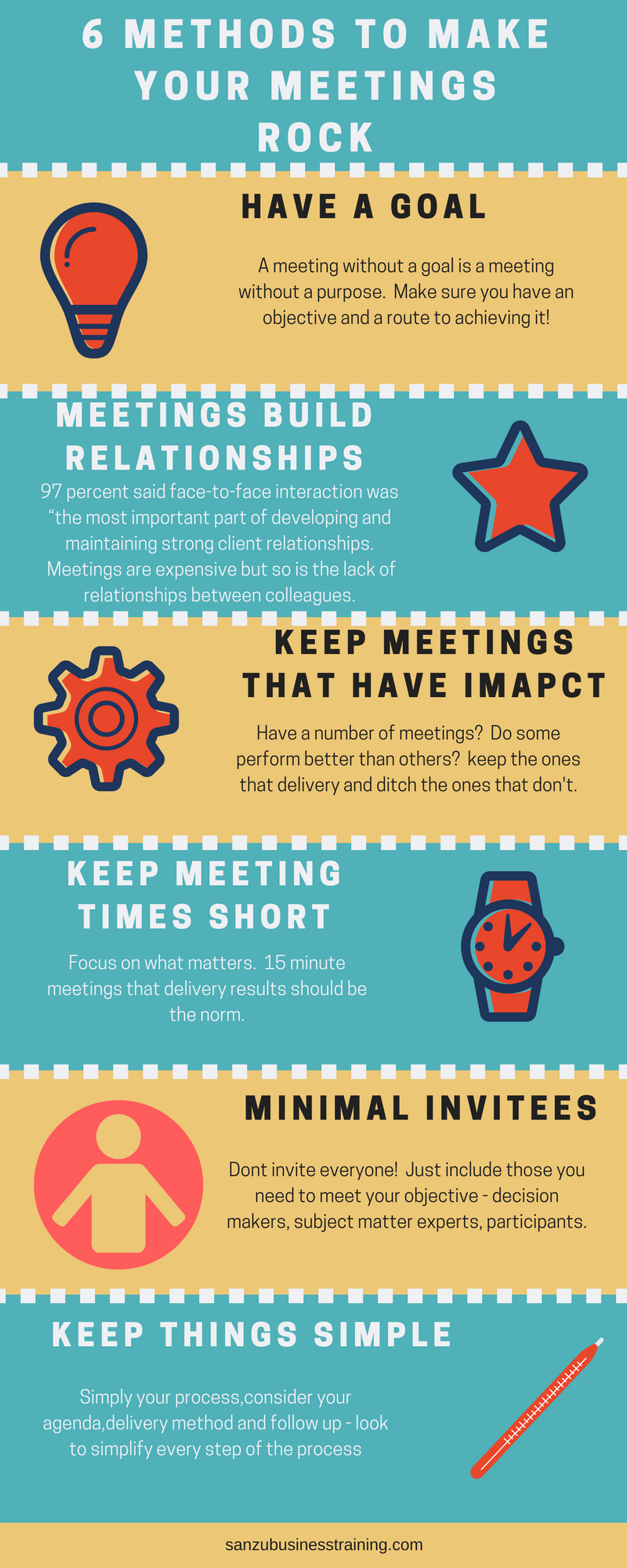We all know that meetings are fair game when it comes to criticism, on the outside they appear an easy target – they take up the valuable time of groups of people and have varying degrees of effectiveness (often none). Do they add any real value? Well that’s up for debate, for example over at inc.com they ask would you have any meetings at all if you could?
There are arguments that state that actually the value of work is in the creative deep thinking parts, that no value is derived from meetings. Indeed, far too many meetings are simply put in to regurgitate information that people already know. There are far more effective ways of doing this that even if decision points are required.
So starting from a low point it is surprising to learn that actually there can be value in the humble business meeting, it’s all in three things:
* Objective
* Setup
* Execution
So here are 6 ideas to make your meetings work for you.
1/ Have a goal
Business meetings are not facilitators for decision making – repeat that to yourself for a moment and tell yourself there are more efficient ways of doing that. So if that’s not your goal what is then. Try asking yourself, can I do this more effectively without a meeting. One example of a meeting that adds value which I’ve seen is the exec review of manufacturing floor status – this meeting only takes 15 mins is run daily and is based around an issues board. This board is the culmination of issues that the shop floor are currently facing that haven’t been addressed in 48hrs i.e. there is help needed. The meeting, which I repeat takes 15 minutes, reviews the issues and provides a course of action agreed by the executives. The goal is zero escalation points left after each daily session. The objective, to keep the manufacturing floor running with zero issues.
2/ Use them to build relationships
Relationships within the business are often key to success. Bluecox.com has an interesting piece which provides the statistic that 97 percent said face-to-face interaction was “the most important part of developing and maintaining strong client relationships,”. So is the objective of the meeting simply to build comrade? Yes, there might be a more effective way of reaching the meeting goal but that would be to the detriment of team building? Perhaps the meeting allows all the colleagues to put their points across and feel equal value, perhaps the meeting facilitates creativity that interaction which a computer screen wouldn’t. Yes, meetings are expensive but so is the lack of relationships between colleagues. (note this point is not an excuse for a gathering of people for idle banter!).
3/ Monitor the impact, keep the ones that deliver
Another consistent criticism of meetings is that they fail to deliver. Here you need to be your own meeting police. Go back over your diary and look at the meetings that you co-ordinated or took part in. Did they deliver their goal? Be honest. For those that didn’t is there another way of achieving it which could be more efficient. If I go back to the example I cited in point 1 – if the 48hr issues had failed to be resolved then clearly the meeting had failed. It would be relatively easy in this instance to look at a metric of meeting the success. How can you apply this to your own work and what would you learn from it?
4/ Reduce meeting times –
I love 15-minute meetings. I feel there’s very little that can’t be achieved in that time and that anything longer isn’t adding value and leads to people that procrastinate and switch subjects. Consider your agenda and how you can turbo-charge it into he shortest time possible while still being able to achieve your goal.
5/ Minimize the invitee list
So you’re friend Joe from accounting always makes you laugh, Claire from marketing always brings biscuits and…STOP. Who do you really need, perhaps you need a subject matter expert, the issue owner, someone empowered to make change? Don’t invite 100 when only 2 or 3 will do.
6/ Simplify the process
A good example here is where you book a meeting for an hr and 45 mins are used to describe the issue. This is an ideal example where you can issue notes ahead of the meeting to provide the team the context fo the discussion. The meeting then needs to be only 15 minutes to drive the goal that you want to achieve.
No matter how hard we try we’ll never fully get rid of meetings. The key is to recognize they can be bad and look to optimize how you run them. Minimizing any wasted time. This takes practice and dedication but can result in much more time for proper work – or chatting by the coffee machine!
Have some ideas for improving meetings? Use our comments section below. In the meantime – here’s our cut out and keep guide to making your meetings rock!
